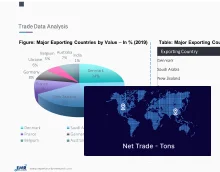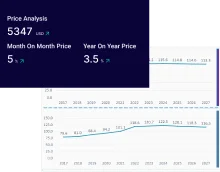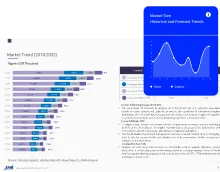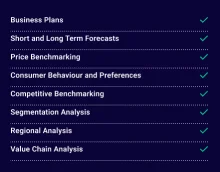
Consumer Insights
Uncover trends and behaviors shaping consumer choices today
Procurement Insights
Optimize your sourcing strategy with key market data
Industry Stats
Stay ahead with the latest trends and market analysis.
The Expert Market Research report, titled “Omega 3 Fatty Acid Manufacturing Plant Project Report 2026 Edition: Industry Trends, Capital Investment, Price Trends, Manufacturing Process, Raw Materials Requirement, Plant Setup, Operating Cost, and Revenue Statistics,” provides an in-depth and comprehensive examination of the financial and operational aspects of establishing an omega 3 fatty acid plant.
The report is the result of extensive primary and secondary research, offering a detailed analysis of current market trends. It profiles key industry players, giving insights into their market strategies, production capacities, and financial performance, which are crucial for benchmarking and competitive analysis.
It delves into historical, current, and forecasted price trends, helping stakeholders understand market dynamics and price volatility. The report provides a thorough analysis of the mass balance and raw materials requirements, ensuring a clear understanding of the input-output ratios essential for efficient production. Detailed examinations of the various unit operations integral to the omega 3 fatty acid manufacturing process are included, highlighting process optimisation techniques and technological advancements.
The report presents a comprehensive capital cost analysis, detailing the financial investment required for setting up an omega 3 fatty acid plant. This includes an exhaustive breakdown of costs associated with raw materials, catchem, utilities, labour, packaging, transportation, land acquisition, construction, and machinery. Additionally, it offers an in-depth look at the operating costs, providing clarity on the recurring expenses involved in running the plant.
Projected profit margins and optimal product pricing strategies are outlined, offering guidance on maximising profitability. The report also addresses regulatory frameworks, environmental impacts, and sustainability measures pertinent to the omega 3 fatty acid industry.
Omega-3 fatty acids, also known as polyunsaturated fatty acids (PUFAs), are essential nutrients crucial for various bodily functions, including heart health, brain function, and anti-inflammatory responses. The three primary types are alpha-linolenic acid (ALA), eicosapentaenoic acid (EPA), and docosahexaenoic acid (DHA). ALA is primarily found in plant sources like flaxseeds, while EPA and DHA are abundant in marine life, particularly fatty fish. The discovery of essential fatty acids began in 1929 when George and Mildred Burr identified the necessity of fatty acids for health through experiments on rats. In the 1970s, research highlighted the cardiovascular benefits of omega-3s, particularly EPA, observed in the diets of Greenland Inuit populations. By the 1980s, DHA was renowned for its critical role in brain development and function, solidifying the importance of omega-3 fatty acids in nutrition.
Omega-3 fatty acids are polyunsaturated fatty acids distinguished by the presence of a double bond three carbon atoms away from the terminal methyl group. They exist primarily in two forms: triglycerides and phospholipids, with molecular structures that vary among types—alpha-linolenic acid (ALA) has 18 carbon atoms and 3 double bonds (C18:3), eicosapentaenoic acid (EPA) has 20 carbon atoms and 5 double bonds (C20:5), and docosahexaenoic acid (DHA) has 22 carbon atoms and 6 double bonds (C22:6). Omega-3 fatty acids are known for their anti-inflammatory and cardioprotective properties, influencing lipid metabolism by reducing triglyceride levels by up to 30% in some studies. Physically, they are typically oily liquids at room temperature, with a viscosity ranging from 0.1 to 0.5 Pa·s, and a tendency to oxidise when exposed to air, leading to rancidity within weeks. Omega-3s also play vital roles in cellular function, forming essential components of cell membranes, where DHA constitutes about 30% of the fatty acids in the brain and retina.
The production process of omega-3 fatty acids begins with source selection, where the source can either be natural, such as fish oil or algae, or through biosynthesis using microorganisms. If natural sources are chosen, omega-3 fatty acids are extracted from fish oil, typically derived from fatty fish like sardines and mackerel, or from microalgae. Alternatively, certain strains of bacteria and yeast can be engineered to produce omega-3 fatty acids through fermentation processes. Following extraction, the oils undergo refining and purification to remove impurities and contaminants. The purified omega-3 fatty acids are then formulated into desired forms, such as triglycerides or ethyl esters. Rigorous quality control measures are then implemented to ensure the purity, potency, and safety of the final products. Finally, the omega-3 fatty acids are packaged for distribution.

Read more about this report - REQUEST FREE SAMPLE COPY IN PDF
1. Extraction of Omega-3 from Natural Sources
Raw materials, such as fish or algae, are crushed and subjected to an extraction process, often using solvents (e.g., hexane) to isolate the crude oil containing omega-3 fatty acids.
General Reaction (simplified):
Fish/Algae → Crude Oil
2. Purification and Transesterification
The crude oil undergoes a process of transesterification, where triglycerides are converted into esters of fatty acids. This involves treating the crude oil with an alcohol (usually methanol) in the presence of a catalyst (e.g., sodium hydroxide).
This reaction helps to separate omega-3 fatty acids in a more concentrated form.
Reaction:
Triglyceride + 3 CH3OH → 3 Fatty Acid Methyl Esters + Glycerol
3. Molecular Distillation
After transesterification, molecular distillation is used to concentrate omega-3 fatty acids by removing unwanted impurities and separating other fatty acids.
General Reaction (for separation):
Fatty Acid Mixture → Concentrated Omega-3 Fatty Acids
4. Re-esterification (Optional)
To enhance bioavailability, the concentrated omega-3 fatty acid methyl esters may undergo re-esterification to convert them back into triglycerides.
Reaction:
3 Fatty Acid Methyl Esters + Glycerol → Triglycerides
Omega-3s are recognised for their role in reducing risks associated with cardiovascular diseases, which affected approximately 127.9 million Americans (48.6% of adults) in 2024, with heart disease being the leading cause of death, accounting for 702,880 fatalities in the previous year. Their use in dietary supplements is particularly significant, with around 8% of American adults reported to use omega-3 fish oil supplements, according to the CDC. Additionally, the rising prevalence of chronic diseases like diabetes, affecting over 37 million Americans (about 11.3% of the population) and arthritis, which impacts approximately 58 million adults (about 24% of the adult population), is propelling demand for omega-3 products due to their anti-inflammatory properties. Furthermore, studies indicate that omega-3 fatty acids can lower triglyceride levels by 30%, which is crucial for managing diabetes.
Moreover, government initiatives in countries like the USA and China are increasingly promoting adequate omega-3 intake due to its ability to address chronic conditions prevalent among the ageing population. In the United States, approximately 127.9 million adults are affected by cardiovascular diseases, with the American Heart Association recommending at least two servings of fatty fish per week to mitigate risks associated with heart disease. In China, where the elderly population is expected to reach 487 million by 2050, government health campaigns are highlighting the importance of omega-3s in reducing inflammation and improving cognitive function. These initiatives are creating new opportunities for market players.
This production cost analysis report by Expert Market Research scrutinises the omega 3 fatty acid manufacturing process, offering a comprehensive overview necessary for stakeholders considering venturing into this sector. Based on the latest economic data, the report encompasses detailed insights into the primary process flow, raw material requirements, reactions involved, utility costs, operating costs, capital investments, pricing strategies, and profit margins. This report is an indispensable resource for entrepreneurs, investors, researchers, consultants, business strategists, and all those who have any kind of stake in the omega 3 fatty acid industry. It equips them with essential information and strategic insights to effectively navigate the complexities of the market.
The following sections detail the comprehensive scope of the prefeasibility report for a omega 3 fatty acid production plant:
This prefeasibility report aims to equip potential investors and existing manufacturers with crucial insights to make informed decisions in the omega 3 fatty acid industry.




*While we strive to always give you current and accurate information, the numbers depicted on the website are indicative and may differ from the actual numbers in the main report. At Expert Market Research, we aim to bring you the latest insights and trends in the market. Using our analyses and forecasts, stakeholders can understand the market dynamics, navigate challenges, and capitalize on opportunities to make data-driven strategic decisions.*
Get in touch with us for a customized solution tailored to your unique requirements and save upto 35%!
Basic Plan
USD 5,699
USD 4,844
Get Startedtax inclusive*
Raw Material and Product Specification, Raw material consumption, Process flow diagram
Machinery Cost, Working Capital
Utilities consumption, Operating cost, Overheads, Financing Charges, GSA , Packaging
Premium Plan
USD 6,799
USD 5,779
Get Startedtax inclusive*
Key Processing Information, Capital Investment Analysis, Conversion Cost Analysis
Raw material consumption and prices, Utilities consumption breakdown, By-Product Credit, Labour Charges Breakdown
Land and Site Cost, Equipment Cost, Auxiliary Equipment Cost, Contingency, Engineering and Consulting Charges
Enterprise Plan
USD 8,899
USD 7,564
Get Startedtax inclusive*
Key Processing Information, Capital Investment Analysis, Conversion Cost Analysis, Variable Cost Breakdown, Investing Cost Breakdown,
Breakdown of machinery cost by equipment, Auxiliary Equipment Cost, Piping, Electrical, Instrumentation
Cost of Construction, Plant Building, Site Development Charges
Land Cost, Development Charges
Dynamic Spreadsheet (Unlocked)
*Please note that the prices mentioned below are starting prices for each bundle type. Kindly contact our team for further details.*

Basic Plan
USD 5,699
USD 4,844
Key Processing Information
Raw Material and Product Specification, Raw Material Consumption, Process Flow Diagram
Capital Investment Analysis
Machinery Cost, Working Capital
Conversion Cost Analysis
Utilities Consumption, Operating Cost, Overheads, Financing Charges, GSA , Packaging

Premium Plan
USD 6,799
USD 5,779
All Contents of Basic Report
Key Processing Information, Capital Investment Analysis, Conversion Cost Analysis
Variable Cost Breakdown
Raw Material Consumption and Prices, Utilities Consumption, Breakdown By-Product Credit, Labour Charges Breakdown
Investing Cost Breakdown
Land and Site Cost, Equipment Cost, Auxiliary Equipment Cost, Contingency, Engineering and Consulting Charges

Enterprise Plan
USD 8,899
USD 7,564
Includes all Report Content
Key Processing Information, Capital Investment Analysis, Conversion Cost Analysis, Variable Cost Breakdown, Investing Cost Breakdown,
Equipment Cost Breakdown
Breakdown of Machinery Cost By Equipment, Auxiliary Equipment Cost, Piping, Electrical, Instrumentation
Land and Construction Cost Details
Land Cost, Development Charges, Cost of Construction, Plant Building, Site Development Charges
Dynamic Excel Cost Model
Dynamic Spreadsheet (Unlocked)
*Please note that the prices mentioned below are starting prices for each bundle type. Kindly contact our team for further details.*
Flash Bundle
Number of Reports: 3
20%
tax inclusive*
Small Business Bundle
Number of Reports: 5
25%
tax inclusive*
Growth Bundle
Number of Reports: 8
30%
tax inclusive*
Enterprise Bundle
Number of Reports: 10
35%
tax inclusive*
How To Order

Select License Type
Choose the right license for your needs and access rights.

Click on ‘Buy Now’
Add the report to your cart with one click and proceed to register.

Select Mode of Payment
Choose a payment option for a secure checkout. You will be redirected accordingly.
Gain insights to stay ahead and seize opportunities.

Get insights & trends for a competitive edge.

Track prices with detailed trend reports.

Analyse trade data for supply chain insights.

Leverage cost reports for smart savings

Enhance supply chain with partnerships.

Connect For More Information
Our expert team of analysts will offer full support and resolve any queries regarding the report, before and after the purchase.
Our expert team of analysts will offer full support and resolve any queries regarding the report, before and after the purchase.
We employ meticulous research methods, blending advanced analytics and expert insights to deliver accurate, actionable industry intelligence, staying ahead of competitors.
Our skilled analysts offer unparalleled competitive advantage with detailed insights on current and emerging markets, ensuring your strategic edge.
We offer an in-depth yet simplified presentation of industry insights and analysis to meet your specific requirements effectively.
Share